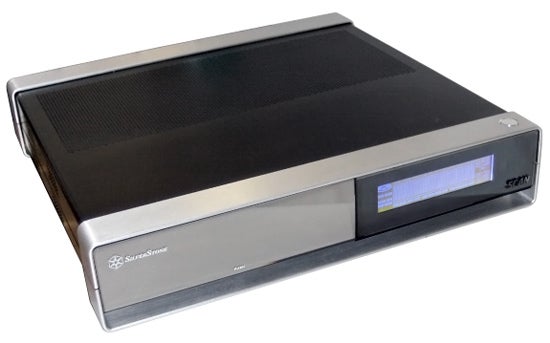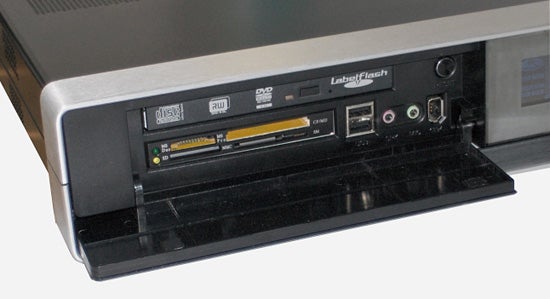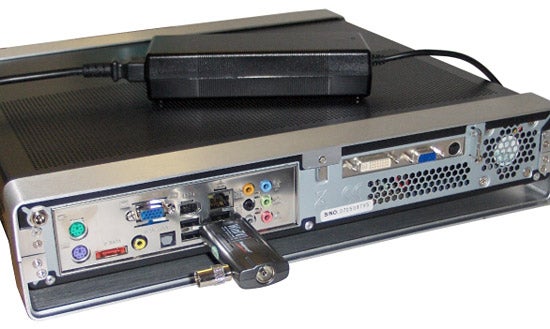Scan 3XS Classic Media Centre Review
Scan 3XS Classic Media Centre
Time to move the PC into the living room? This slimline offering could be just what you need.

Verdict
Key Specifications
- Review Price: £1000.00
Media Center PCs for use in a living room continue to sell well and Scan has decided to add a machine which looks much more like a hi-fi component than a PC. Supplied without monitor, keyboard or mouse for £1,000, it’s designed for use with the Media Center front-end within Windows Vista Home Premium.
It’s quite possible to use a PC of this type exclusively with a Windows remote control and with it you can view photos, TV and DVD movies and listen to digital radio, CDs and downloaded tracks, as well as streaming audio and video from the Internet.
The 3XS Classic Media Centre is built into a Media Centre case (the ML02) from SilverStone, a Taiwanese supplier which produces a lot of good-looking cases for specialist builds. This one is low-profile, though with a large footprint, and the internal components are heavily ventilated, so you won’t want to put anything on top of the case. Aluminium bands at the front and back of the case act as feet and lift the whole PC off the desk by a centimetre or so.
At front right is a liquid crystal display, which variously shows the buttons being pressed on the remote or a graphic equaliser. There are also icons for most of the types of media you may want to run. It looks suitably techie, but doesn’t serve much practical purpose when you’re running Media Center. Next to the display is a mirror-fronted panel which folds down to reveal a notebook-style DVD rewriter, a four-slot, multi-card reader, front-panel mic, line out, USB and FireWire sockets and a reset button.
Round the back are S/PDIF sockets, external SATA and 5.1 sound – which sounds good despite coming from a mainboard sound chip – as well as more USB and FireWire outlets. Power is provided by a substantial ‘black block’ power supply, which will have to be secreted away somewhere.
One of the features Scan was keen to tell us about was its HD compatibility, and the company has chosen an nVidia 8500 graphics card from Asus because of its full HD driver support and quiet fan – an important factor in a Media Center system. That’s HD on the video end, with HDCP-compliant output, not on the DVD end. There’s a slim-line, 8x DVD rewriter built into the machine, but while this is DVD±RW with support for Labelflash disc label writing, it isn’t either Blu-Ray or HD-DVD-compatible. Internal storage is provided by a 750GB SATA hard drive, which should be enough for many hours of personal recording, even at HD resolutions.
The whole system is powered by an Intel Core 2 Duo T7200 processor running at 2GHz and this is coupled to 2GB of DDR2 memory – a solid specification for a machine designed to run a variety of media.
Once you’ve started the machine and are running Media Center, the 3XS Classic Media Centre is very easy to use with the remote – though note my comments later on the actual remote control. It handled all the media we threw at it with no signs of struggling and was commendably quiet, even though it has fans.
Unlike some earlier Media Center-style machines, which had a simple operating system dedicated to handling CD playback without starting Windows, the 3XS Classic Media Centre does need it running, but of course Windows Vista has a good set of stand-by options and the machine takes little power when switched to hibernation mode. You then get a quick start-up when you want to play media.
There are a few rough edges though. The Windows remote control is not that sensitive and we had to press buttons several times to get a response. Scan says SilverStone is working on improved drivers and that the machine will be supplied with Microsoft’s external receiver, too, which in our experience provides a very robust connection.
The dual DVB-T digital TV tuner is a neat little USB dongle from Hauppauge, but it’s not neat enough to prevent it blocking the other three USB sockets when you plug it into the fourth. Scan supplies a USB extension cable to get round this.
Our review sample also started to the Windows Vista desktop, and the Media Center icon wasn’t installed on the desktop. If the machine’s intended for the less experienced customer, and is supplied without keyboard or mouse, it would be better to start straight to Media Center – Scan says this will be the default.
It’s a shame wireless networking isn’t built-in, as having to run cables room to room for Internet access or to link to a home server can be messy. Cabled networking is supplied, of course, but in a £1,000 machine it should be more than the option it currently is.
We tried to run PCMark 05, but received an error message about video buffer set-up. This is nothing to worry about and is largely due to the very new state of the nVidia 8500 drivers. Scan will be updating the card within the next week or so.
”’Verdict”’
The machine we saw was just at the end of its development cycle, so our minor criticisms are likely to be dealt with by the time the system is released. The 3XS Classic Media Centre is a very effective Media Center and looks sleek and purposeful. We’d have liked to see wireless networking built in and for it to be a tad cheaper. Even with the fancy low-profile case, it’s around £200 more than the mainstream competition.

Trusted Score
Score in detail
-
Value 6
-
Features 8
-
Performance 8

